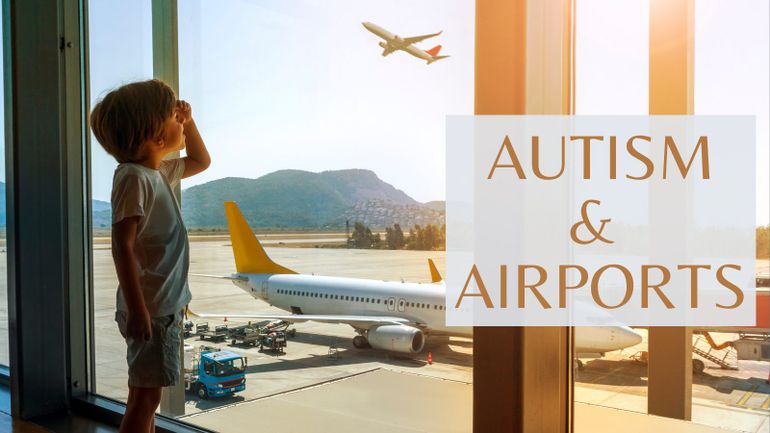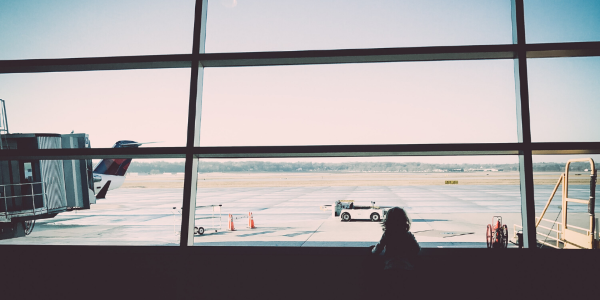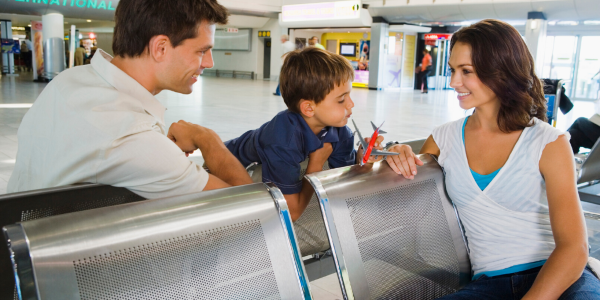Autism and UK airports – Improving assistance for passengers with autism

We asked parents of children with ASD to give us some insights into the particular issues that they face when taking a child through the airport, some of their tips to get through it, and what they think airports should be doing to help make this journey easier for them.
Over 80% of parents of children with Autism Spectrum Disorder responded that the airport experience is a particularly daunting one in a recent survey conducted by Airport Parking Shop. Children with autism are likely to find airports very problematic, which is unsurprising given that it is a scenario far removed from everyday life. Queuing, security, announcements, crowds and more can all combine to make it a pretty overwhelming experience for anyone with ASD, but in particular children.
In recent years, there have been a lot more autism friendly airports! Manchester Airport led the way for a while in the UK, with booklets available on each terminal, but these have since been removed. You can still request a lanyard for passengers with a hidden disability though. Other airports such as Gatwick offer visual booklet, whilst Newcastle Airport have trained their staff on autism awareness and now offer an Autism Passport which allows holders to Fast Track through security and Heathrow now offer Sunflower Lanyards to those with a hidden disability.
Airports are getting better and better at helping those with autism through the experience and since writing this blog, there have been a lot more autism friendly airports! In the table below, you can see what each airport has available to date. We will try to keep this updated. Continue reading to discover more about what our survey respondents said.
Autism Friendly Airports:
Click the plane emoji ✈️ in each row to be taken to the official airport information.
| Airport | Details of assistance available |
|---|---|
| Aberdeen Airport | Booklets about the airport, familiarisation visits, videos and lanyards are available. ✈️ |
| Belfast City Airport | The airport offers 5 videos on the various aspects of the airport journey from the “child’s eye view”, plus a green Hidden Disabilities lanyard. They also offer familiarisation visits! ✈️ |
| Belfast International Airport | Booklets for both children and adults are available. On top of that, there are Autism Awareness lanyards available at the airport. The lanyard gives you access to the left-hand Priority Lanes at security. You will then be guided to a Special Assistance Lane from there. ✈️ |
| Birmingham Airport | It has been given the Autism Friendly Award. Lanyards are available for the journey and informative booklets for adults with autism or parents of children with autism. They’ve helpful videos that can be accessed too. ✈️ |
| Bristol Airport | It has been given the Autism Friendly Award. Lanyards, hidden disabilities special assistance cards, booklets and videos on aspects of the airport are all available. ✈️ |
| Cardiff Airport | The airport has lanyards and also provides familiarisation visits. ✈️ |
| East Midlands Airport |
You can book their “try before you fly” visits to familiarise yourself with the airport and there are lanyards to alert staff in the airport. They also have quiet rooms available if you wanted to escape the busy airport. ✈️ |
| Edinburgh Airport | It is been given the Autism Friendly Award. Lanyards and pins are available. To help you ease into the journey, the airport has a social story which you can download. They also have quite spaces if you want to get away from all the hustle bustle. ✈️ |
| Gatwick Airport | The airport has an Autism Friendly Award. They offer lanyards which can be worn. In addition, North Terminal now has a sensory room for those travelling who might benefit from a calm and relaxed environment before their flight. ✈️ |
| Glasgow Airport | Lanyards, and a downloadable guide to the airport are available. ✈️ |
| Heathrow Airport | Sunflower lanyards can be worn to alert airport staff that you may need assistance. ✈️ |
| Leeds Bradford Airport | Lanyards and guide in conjunction with Leeds Autism Services are available. ✈️ |
| Liverpool Airport | Sunflower lanyards and Butterfly Flyer are available, as well as familiarisation visit to ther airport beforehand. ✈️ |
| London City Airport | You can contact the airport in advance and arrange for someone to greet you at the airport and walk you through to departures. Once you reach the departure lounge, you can use the airport’s Westpier which is a much quieter area. The airport recommends that you fly between 11am to 4pm as that’s a time when the airport is quieter. They also offer familiarisation session! ✈️ |
| Luton Airport | There are lanyards and guides available for those with hidden disabilities. They also have a quiet room that you can access and is is located next to Gate 17. ✈️ |
| Manchester Airport | Lanyards are available and allow the wearer and their family access to family and priority lanes at security as well as the special assistance lanes at the UK Border on arrival. There is also a Sunflower Room in Terminal 1 to help those with Special Assistance if you want to get away from the crowds.✈️ |
| Newcastle Airport | You can get an Autism passport to help you through the journey which also includes the use of Fast Track. A guide to the airport and an activity booklet are also available. ✈️ |
| Prestwick Airport | Lanyard available for persons with hidden disabilities. ✈️ |
| Southampton Airport | Green Helping Hands lanyards and booklets are available. You can also use their quiet route if you wanted to avoid the crowds. ✈️ |
| Stansted Airport | The airport has Sunflower lanyards for those with hidden disabilities. ✈️ |
| Teesside Airport | The airport has sunflower lanyards available for those with hidden disabilities. ✈️ |
As you can see, most airports are really making a difference in what they offer to passengers.
Travelling with autism – tips from our survey respondents
Our respondents replied with three key factors to consider when deciding to go abroad with their child on the autistic spectrum.
Flight length
When travelling, you want to keep your child comfortable at all times. Flight length is key to this – look at locations where you are going to keep the flight time as short as possible. With all the time at the airport at both ends to factor in, having to deal with a long flight on top of this could be too much to cope with.
Airport size
Some airports are more intimidating than others. If crowds and noise are big concerns for you, perhaps look at a more regional airport to fly from. Flying from somewhere like Bristol may be a quieter option than going from a major London airport.
Destination
There are of course a lot of factors to consider here, but think carefully about the time of year you are going. Is your chosen location a popular tourist destination? If so try to avoid the peak season or you won’t just be dealing with crowds at the airport. Will there be enough to keep the family entertained? Think about the food; is there enough variety and will you be able to get any particular food that your child won’t do without?
Time difference is another issue to consider, if there is a large time difference will this affect your child?
Things to watch out for
If have done your research and have decided to go abroad with your child, our survey respondents gave us some ideas of the things at airports that caused an issue.
- First off, you have the big things that come with airports such as crowds, queues, and noise. Unless you have a very early flight or a very late flight, you are likely to encounter a lot of people. This means there will be queueing for nearly everything, and of course, a lot of noise. You may find that personal space becomes an issue, with people being impatient in queues or rushing to get to where they need to be.
- Security is a pretty big deal – you will have to cope with all of the above on the wait to go through, and then there is the body scanner and the staff to deal with. Several times we were told about families coming up against issues at this point, with a parent being unable to go through the scanner with the child, or even worse, being separated. You should make it very clear from the beginning that your child has additional needs.
- Unfortunately, you may also have to deal with other people staring, commenting, and so on. This is not helpful at all but unfortunately something a lot of our survey respondents had to deal with, especially when skipping queues and so on.
- Check your seating on the plane. Sometimes you will have to pay extra to book seats in advance, although it may seem like an annoyance at the time, this is well worth doing as airlines have been known to split up families, even with young children. If you book your seats in advance this is one less worry!
- Announcements are everywhere in airports and on planes, so if your child finds these disturbing make sure you pack headphones, earphones, or even ear defenders. Even on planes during quiet moments there can be an announcement at any time, and sod’s law it will come just as your child is finally drifting off to sleep!
Tips for Travelling with Autism

So, how do you deal with the myriad of complications? Of course, the above are just some of the things to keep in mind, there are plenty more and you will know what is most likely to affect your child.
Preparation! Don’t be afraid to contact everyone and anyone in advance. Contact the airport, the airline, and anyone else who you may encounter during your trip. You will never know what they will be able to help you with unless you ask. You should be able to get access to Special Assistance at the airport, which will help you fast track through queues.
Distractions are important. These could be headphones, ear defenders, iPods, iPads, Nintendo DSes or other handheld gaming devices. Remember however that your child will have to part with these in order for the device to be scanned at security, so bear this in mind! Or perhaps take a comfort item that your child is attached to, a soft toy, blanket or similar.
Utilise as much material as you can, for example Social Stories. This is where Manchester Airport has really helped matters by providing videos walking through the airport, however you can create pictures and documents to help envisage the journey through the airport and prepare your child for the different noises and sights they might see.
You can create timetables and checklists for your child to follow through.
This might enable you to pinpoint any problems in advance and help your child overcome them prior to the actual journey. Contact the airport and see if there is any chance of visiting in advance to do a “pretend” trip through the airport so it is not all new. This has become more and more possible in America, but it will depend on the airport itself and how close you live to the airport in question!
Remember that it’s okay to have a “whoops!” moment, or to make mistakes. It’s a new, scary experience for all of you, and it’s just about making it as comfortable as possible.
Look at your budget and decide whether you can book a lounge. It depends on which lounge and which airport, but many allow you to book in advance and have access for a few hours before your flight. These are usually much calmer and quieter places, with some food and drinks available, quieter seating areas and some magazines and so on. So it can be a great idea to book a lounge!
How can airports improve?
Airport may always be more complicated when travelling with a child or adult with ASD, but there are some steps that airports can take to simplify the process. They are already improving the disabled facilities, for example more and more are introducing Changing Places and Eagle 2 Lifter, so continuing this trend for those needing other forms of Special Assistance should be a no brainer!
Our respondents agreed on several points that would make their journeys a lot simpler!
Fast track
Fast track, Special Assistance, queue jump, whatever you want to call it, this is really necessary for families travelling together. This combined with Priority Boarding could go a long way to help families with children with ASD travel smoothly through the airport with minimal waiting around.
Visiting the airport beforehand
Being able to arrange to visit the airport before your flight and introduce your child to the environment could go a long way to helping them feel more relaxed in the airport and know what to expect. Some airports in America have been offering this, and some UK airports have mentioned that it is possible. It may be worth contacting the airport in advance and see what they can do, especially if you are fairly local!
A dedicated lounge
There are many commercially run lounges available at airports, but a dedicated special assistance lounge could provide the necessary calm and quiet environment to keep children with ASD within their comfort zone whilst they have to wait around.
In March 2017 Shannon Airport opened a Sensory Room, where passengers with ASD may go to relax away from the busy hustle and bustle of the airport. It was designed by Adam & Friends and will surely lead the way for similar initiatives at other airports. Following suit in October 2018 was Gatwick Airport, with the opening of their Sensory Room, providing a chilled and calming environment.
Wide-spread ASD training
UK airport staff are given training on how to assist those requiring special assistance, however this is often limited to those needing wheelchairs or those with physical disabilities. Our respondents suggested that more specific training in regards to customers with ASD would be beneficial in helping them to understand how best to help these passengers.
Keep families together

Far too many respondents to our survey mentioned being split up from their children at varying points in their airport journey. This is entirely unacceptable for any family, let alone a family with children with ASD!
If you are worried about not being seated together then read our helpful guide on how to avoid being split up with your family.
We are very grateful to all those who responded to our survey, and we hope that some of the tips and advice provided can help others travelling through airports with children! It’s time now for airports to really step up and improve the assistance on offer to those with ASD, hopefully by incorporating some of the suggestions above.